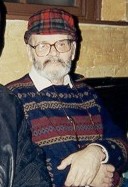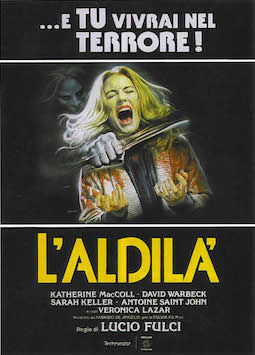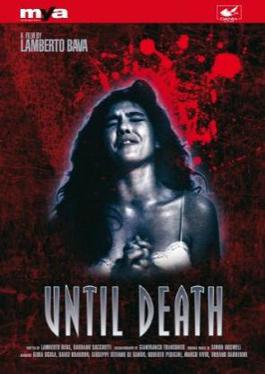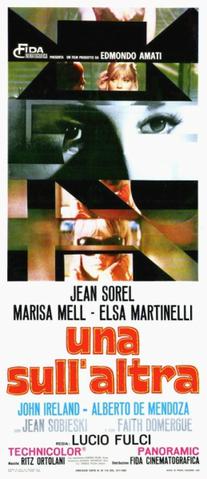
Lucio Fulci was an Italian film director, screenwriter, and actor. Although he worked in a wide array of genres through a career spanning nearly five decades, including comedies and spaghetti Westerns, he garnered an international cult following for his giallo and horror films.

Mario Bava was an Italian filmmaker who worked variously as a director, cinematographer, special effects artist and screenwriter. His low-budget genre films, known for their distinctive visual flair and stylish technical ingenuity, feature recurring themes and imagery concerning the conflict between illusion and reality, as well as the destructive capacity of human nature. Widely regarded as a pioneer of Italian genre cinema and one of the most influential auteurs of the horror film genre, he is popularly referred to as the "Master of Italian Horror" and the "Master of the Macabre".

Zombi 2 is a 1979 English-language Italian zombie film directed by Lucio Fulci. It was adapted from an original screenplay by Dardano Sacchetti to serve as a sequel to George A. Romero's Dawn of the Dead (1978), which was released in Italy under the title Zombi. It stars Tisa Farrow, Ian McCulloch, and Richard Johnson, and features a score by frequent Fulci collaborator Fabio Frizzi. Frizzi's score has been released independently of the film, and he has performed it live on tour.

The Beyond is a 1981 English-language Italian Southern Gothic supernatural horror film directed by Lucio Fulci. It is based on an original story created by Dardano Sacchetti, starring Catriona MacColl and David Warbeck. Its plot follows a woman who inherits a hotel in rural Louisiana that was once the site of a horrific murder, and which may be a gateway to hell. It is the second film in Fulci's Gates of Hell trilogy after City of the Living Dead (1980), and was followed by The House by the Cemetery (1981).

The New York Ripper is a 1982 English-language Italian giallo film directed by Lucio Fulci. The film is about a police lieutenant who is tracking a sadistic killer who slashes women with a switchblade and straight-razors.

Carlo Rambaldi was an Italian special effects and makeup effects artist. He was the winner of three Academy Awards: one Special Achievement Academy Award for Best Visual Effects in 1977 for the 1976 version of King Kong and two Academy Awards for Best Visual Effects in 1980 and 1983 for, respectively, Alien (1979) and E.T. the Extra-Terrestrial (1982). He is most famous for his work in those two last mentioned films, that is for the mechanical head-effects for the creature in Alien and the design of the title character of E.T. the Extra-Terrestrial. In 2017, he was inducted into the Visual Effects Society Hall of Fame.

The House by the Cemetery is a 1981 Italian horror film directed by Lucio Fulci. The film stars Catriona MacColl, Paolo Malco, Ania Pieroni, Giovanni Frezza, Silvia Collatina and Dagmar Lassander. Its plot revolves around a series of murders committed by a ghoulish and demonic serial killer taking place in a New England home that happens to be hiding a gruesome secret within its basement walls.
Dardano Sacchetti is an Italian screenwriter who often worked with Italian directors Lamberto Bava and Lucio Fulci.
Claudio Fragasso is a film director and screenwriter. Fragasso first attempted to make art films in the early 1970s, then became a screenwriter in the Italian film industry in the mid-1970s. Fragasso met director Bruno Mattei, which led to a ten-year partnership from 1980 to 1990 during which the two worked together closely on films, with Fragasso's contributions often going uncredited. Fragasso's wife Rossella Drudi was also a screenwriter and collaborated with him on a number of projects. Fragasso would later go on to write and direct his own films in the 1980s, including Monster Dog with rock musician Alice Cooper and After Death. Fragasso directed Troll 2 in 1989, which was later the topic of Best Worst Movie, a documentary film that discussed Troll 2's fandom.

City of the Living Dead is a 1980 Italian supernatural horror film co-written and directed by Lucio Fulci. It stars Christopher George, Catriona MacColl, Carlo de Mejo, Antonella Interlenghi, Giovanni Lombardo Radice, and Janet Agren. The film follows a priest whose suicide opens a gateway to hell that releases the undead. A psychic and a reporter team up to close it before All Saints' Day.

Until Death is a 1988 Italian made-for-TV horror film directed by Lamberto Bava.

Manhattan Baby is a 1982 Italian horror film directed by Lucio Fulci, and starring Christopher Connelly and Carlo De Mejo. The film begins in Egypt, where Susie, the daughter of archaeologist George Hacker, is given a mysterious talisman by an old woman. Meanwhile, her father investigates a tomb, and is blinded by a blue light. George and Susie return to New York, where George gradually recovers his vision. Strange deaths begin to occur around the Hackers, seemingly caused by the amulet.
Sergio Salvati is an Italian cinematographer who was born in Trastevere, a working-class neighborhood of Rome, Italy. His father, Aldofo Salvati, was already a key grip in the early days of Italian cinema, and through his father's contacts Sergio began his career developing negatives in a small photographic laboratory in Rome, the SPES directed by Di Ettore Catalucci.

Sette note in nero is a 1977 Italian giallo film directed by Lucio Fulci and co-written by him with Roberto Gianviti and Dardano Sacchetti. Sette note in nero stars Jennifer O'Neill, Gianni Garko, Marc Porel, and Ida Galli. The film involves a woman who begins experiencing psychic visions that lead her to discover a murder; her husband is charged with the killing. The psychic must embark on an investigation with a paranormal researcher to clear her husband's name of the crime.

Cold Eyes of Fear is a 1971 Italian-Spanish thriller film directed by Enzo G. Castellari, starring Fernando Rey.

One on Top of the Other, also known as Perversion Story, is a 1969 giallo film directed by Lucio Fulci. Written by Fulci and Roberto Gianviti, the film stars Jean Sorel, Marisa Mell, Elsa Martinelli, Alberto de Mendoza and John Ireland. The first giallo directed by Fulci, its plot concerns George Dumurrier (Sorel), an unscrupulous San Franciscan doctor who is suspected of orchestrating the death of his asthmatic wife Susan (Mell) as part of an insurance scam, despite her seeming reemergence as Monica Weston, a high-class stripper.

My Sister in Law is an Italian commedia sexy all'italiana directed by Lucio Fulci and starring Edwige Fenech.

Wax Mask is a 1997 gothic horror film. The film is set in Rome where a Wax Museum has opened up, whose main attraction is gruesome murder scenes. Shortly after its opening, people began to vanish as new figures appear in the museum.
Fabrizio De Angelis is an Italian director, screenwriter and producer.

Sergio Stivaletti is an Italian special effects artist, make-up artist, director and screenwriter.
















